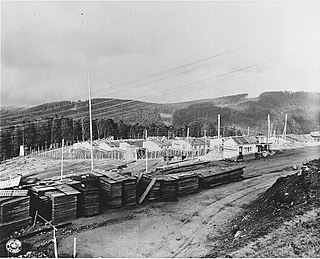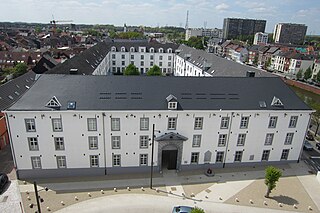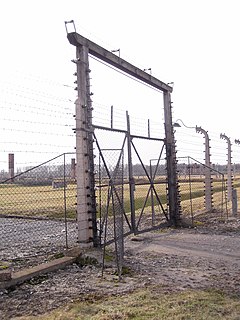
Natzweiler-Struthof was a Nazi concentration camp located in the Vosges Mountains close to the villages of Natzweiler and Struthof in the Gau Baden-Alsace of Germany, on territory annexed from France on a de facto basis in 1940. It operated from 21 May 1941 to September 1944, and was the only concentration camp established by the Germans in the territory of pre-war France. The camp was located in a heavily-forested and isolated area at an elevation of 800 metres (2,600 ft).

Alois Brunner was an Austrian Schutzstaffel (SS) SS-Hauptsturmführer who played a significant role in the implementation of the Holocaust through rounding up and deporting Jews in occupied Austria, Greece, Macedonia, France, and finally Slovakia during the Second World War. He was known as Adolf Eichmann's right-hand man.

Karl Josef Silberbauer was an Austrian police officer, SS member and undercover investigator for the West German Federal Intelligence Service. He was stationed in Nazi-occupied Amsterdam during World War II, where he was promoted to the rank of Hauptscharführer. In 1963, Silberbauer, by then an Inspector in the Vienna police, was exposed as the commander of the 1944 Gestapo raid on the Secret Annex and the arrests of Anne Frank, her fellow fugitives, and two of their protectors, Victor Kugler and Johannes Kleiman.

Drancy internment camp was an assembly and detention camp for confining Jews who were later deported to the extermination camps during the German occupation of France during World War II. Originally conceived and built as a modernist urban community under the name La Cité de la Muette, it was located in Drancy, a northeastern suburb of Paris, France.

Rezső Kasztner, also known as Rudolf Israel Kastner, was a Hungarian-Israeli journalist and lawyer who became known for having helped Jews escape from occupied Europe during the Holocaust. He was assassinated in 1957 after an Israeli court accused him of having collaborated with the Nazis.

Alma Maria Rosé was an Austrian violinist of Jewish descent. Her uncle was the composer Gustav Mahler. She was deported by the Nazis to the concentration camp at Auschwitz-Birkenau. There, for 10 months, she directed an orchestra of female prisoners who played for their captors to stay alive. As director, Rosé held the status of kapo of the music block.

Jewish resistance under Nazi rule took various forms of organized underground activities conducted against German occupation regimes in Europe by Jews during World War II. According to historian Yehuda Bauer, Jewish resistance was defined as actions that were taken against all laws and actions acted by Germans. The term is particularly connected with the Holocaust and includes a multitude of different social responses by those oppressed, as well as both passive and armed resistance conducted by Jews themselves.

Rudolf "Rudi" Vrba was a Slovak-Jewish biochemist who, as a teenager in 1942, was deported to the Auschwitz concentration camp in German-occupied Poland. He escaped from the camp in April 1944, at the height of the Holocaust, and co-wrote a detailed report about the mass murder taking place there. Distribution of the report by George Mantello in Switzerland is credited with having halted the mass deportation of Hungary's Jews to Auschwitz in July 1944, saving more than 200,000 lives. After the war, Vrba trained as a biochemist, working mostly in England and Canada.

The issue of why the Allies did not act on early reports of atrocities in the Auschwitz concentration camp by destroying it or its railways by air during World War II has been a subject of controversy since the late 1970s. Brought to public attention by a 1978 article from historian David Wyman, it has been described by Michael Berenbaum as "a moral question emblematic of the Allied response to the plight of the Jews during the Holocaust", and whether or not the Allies had the requisite knowledge and the technical capability to act continues to be explored by historians. The U.S. government followed the military's strong advice to always keep the defeat of Germany the paramount objective, and refused to tolerate outside civilian advice regarding alternative military operations. No major American Jewish organizations recommended bombing.

Leo Bretholz was a Holocaust survivor who, in 1942, escaped from a train heading for Auschwitz. He has also written a book on his experiences, titled Leap into Darkness.

The Mechelen transit camp, officially SS-Sammellager Mecheln in German, also known as the Dossin barracks, was a detention and deportation camp established in a former army barracks at Mechelen in German-occupied Belgium. It served as a point to gather Belgian Jews and Romani ahead of their deportation to concentration and extermination camps in Eastern Europe during the Holocaust.

The Höcker Album is a collection of photographs believed to have been collected by Karl-Friedrich Höcker, an officer in the SS during the Nazi regime in Germany. It contains over one hundred images of the lives and living conditions of the officers and administrators who ran the Auschwitz-Birkenau concentration camp complex. The album is unique and an indispensable document of the Holocaust; it is now in the archives of the United States Holocaust Memorial Museum (USHMM) in Washington, D.C.

Witold's Report, also known as Pilecki's Report, is a report about the Auschwitz concentration camp written in 1943 by Witold Pilecki, a Polish military officer and member of the Polish resistance. Pilecki volunteered in 1940 to be imprisoned in Auschwitz to organize a resistance movement and send out information about the camp. He escaped from Auschwitz in April 1943. His was the first comprehensive record of a Holocaust death camp to be obtained by the Allies.

Amon Leopold Göth was an Austrian SS functionary and war criminal. He served as the commandant of the Kraków-Płaszów concentration camp in Płaszów in German-occupied Poland for most of the camp's existence during World War II.

On the night of 5 April 1944, Siegfried Lederer, a Czech Jew, escaped from the Auschwitz concentration camp wearing an SS uniform provided by SS-Rottenführer Viktor Pestek. Pestek opposed the Holocaust; he was a devout Catholic and was infatuated with Renée Neumann, a Jewish prisoner. Pestek accompanied Lederer out of the camp, and the two men traveled together to the Protectorate of Bohemia and Moravia to obtain false documents for Neumann and her mother.
Czesław Mordowicz was a Polish Jew who, with Arnošt Rosin, escaped from the Auschwitz concentration camp in German-occupied Poland on 27 May 1944, at the height of the Holocaust. A seven-page report dictated by Mordowicz and Rosin joined the Vrba–Wetzler report and a report by Jerzy Tabeau to become the Auschwitz Protocols, a detailed account of the mass murder taking place inside the camp.

Leo Holzer was an Austrian-Czech firefighter and Holocaust survivor best known for leading the fire brigade inside Theresienstadt concentration camp, which he used as a cover for resistance activities. After the war, he remained in communist Czechoslovakia and became an advocate for Czech-German reconciliation.

The rue Sainte-Catherine Roundup was a Nazi raid and mass arrest of Jews in Lyon's Sainte-Catherine street by the Gestapo. The raid, ordered and personally overseen by Klaus Barbie, took place on 9 February 1943 at the Fédération des sociétés juives de France, then located at the number 12 of this street. To catch as many people as possible, the Nazis not only chose the day the Federation normally gave free medical treatment and food to poor Jewish refugees, but they also set up a trap by forcing arrested Federation employees to encourage further people to come to the 12 rue Sainte Catherine.
Max Scheuer was an Austrian international footballer who played the defender position. He played for the Austrian national football team in the 1923 season. In the 1920s he played for and captained Hakoah Vienna. He was murdered in the Auschwitz concentration camp.

















